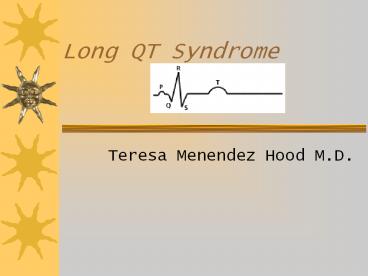Long QT Syndrome - PowerPoint PPT Presentation
Title:
Long QT Syndrome
Description:
Long QT Syndrome Teresa Menendez Hood M.D. LQTS :Facts Abnormalities of ion channels that result in long QT intervals ( prolongation of phase III-time for ... – PowerPoint PPT presentation
Number of Views:549
Avg rating:3.0/5.0
Title: Long QT Syndrome
1
Long QT Syndrome
- Teresa Menendez Hood M.D.
2
LQTS Facts
- Abnormalities of ion channels that result in
long QT intervals ( prolongation of phase
III-time for repolarization) and predispose to
polymorphous ventricular tachycardia (Torsade de
Pointe) - Common cause of sudden death in children and
young adults - 17000 births
- In the US it causes 5 of the SCD/year
- Symptoms include syncope or SCD usually with
physical activity or emotional stress
3
LQTSFacts
- Prolonged recovery from electrical excitation
contributes to increased likelihood of dispersion
of refractoriness. - Consequently, the wave of excitation may pursue
a distinctive pathway around a focal point in
myocardium (circus reentrant rhythm), leading to
polymorphous ventricular tachycardia. syncope
and possibly sudden death.
4
LQTSFacts
- QT prolongation in LQTS is due to overload of
myocardial cells with positively charged ions
during ventricular repolarization (not enough K
getting out or too much Na in ) - In LQT1, LQT2, LQT5, and LQT6 types, potassium
ion channels are blocked or they open with a
delay or are open for a shorter period than in
normally functioning channels, leading to
decreased potassium outward current and prolonged
repolarization. In LQT3, caused by mutations of
the SCN5A sodium channel gene, persistent inward
sodium current contributes to prolonged
repolarization.
5
LQTSFacts
- Syncope often misdiagnosed as vasovagal or
epilepsy - Family history is important-ask about deafness
and SCD lt30 years of age - 1/3 of patients with LQTS are asymptomatic
- 10 of patients will have a normal QT interval
- Rule out drug induced LQT and other causes of SCD
in young patients(HCM,Brugada,ARVD) - Treatment is BB /- ICD
6
LQTSFacts
- Gender differences SCD- males-higher risk during
childhood with mean age 13 of SCD and females
have higher risk in adulthood with mean age of 20
of SCD - Women are twice as likely to be symptomatic and
develop TdP than their male counterparts (the
estrogen?) - Competitive sports should be avoided
- Most episodes result in syncope with only 5
resulting in SCD - EP studies are not helpful
7
LQTS Facts
- Inherited/Congenital first described in 1957
with an autosomal dominant type (Romano Ward)
and an autosomal recessive type (Jervell
Lange-Nielsen). In the 1990s the genetic
mutations have been linked to at least 6 genes
and 2 ion channels. - JLN-deafness, auto R, rare (lt1 of all
LQTS)needs to be homozygous and involves K
consduction in the cilia of the ear - RW-common,hearing is normal,auto D
8
LQTSFacts
- With treatment, can lower the mortality from 10
at 10 years to lt1 - BB prevent symptoms is 70 of patients
- ICDs are indicated for those who have not
responded to BB - TdPAcutely need to treat with defibrillation, IV
magnesium, consider temporary pacing if
bradycardic ,and remove offending drugs - Need to avoid drugs which can further prolong the
QT-www.qtdrugs.org
9
LQTS The EKG
- Measure the QT corrected via the Bazetts formula
and look for T-wave abnormalities - Do not rely on the automated QTc from the
computer read EKG - T wave abnormalities wide based, double hump,
T-U complex, low amplitude - Do an EKG on the parents and siblings
- Take an average of 3 QTc intervals
10
(No Transcript)
11
LQTS Calculating the QTc
- Bazett 1920 QTcQT/square root of the RR
- Corrects QT for the heart rate-there is normally
an inverse relationas one goes up/the other goes
down and vice versa - Abnormal if QTc in males gt470 ms and females of gt
480 ms - Borderline prolonged QTc 450-470 ms
- Average QTc for someone with the LQTS is 490 ms
12
LQTS Nomogram
13
LQTSGenetics
- Not all is known since 40 of families with LQTS
have not yet been linked to the known genetic
causes - LQT1-LQT7
- All encode for K channels except LQT3 which is
linked to the Na channel-very good test question.
14
LQTS Geneticstype/gene/chromosome/comment
- LQT1 KCNQ1 (KvLQT1) 11 Trigger Stress
Iksassociated with JLN - LQT2 KCNH2 (hERG) 7 Trigger Noise Ikr
- LQTS1 and 2 87 of known LQTS
- LQT3 SCN5A 3 Trigger Sleep, rest. Beta
blocker therapy seems to be the less effective
Ina8 of known LQTS - LQT4 ?????
15
LQTSGenetics type/gene/chromosome/comment
- LQT5 KCNE1 21 Associated to the JLNIks
- LQT6 KCNE2-MiRP1 21 Triggers certain
drugs, exerciseIkr - LQT7 KCNJ2 17 Associated to the Andersen
syndrome (periodic paralysis and skeletal
developmental abnormalities)
16
Diagnostic Criteria for LQTS
- 1. EKG findings
- QTc
- gt480 3
- 460-470 2
- 450 (male) 1
17
Diagnostic Criteria for LQTS
- Torsdade De Pointes 2
- T-wave alternans 1
- Notched T wave in 3 leads 1
- Low heart rate for age 0.5
18
Diagnostic Criteria for LQTS
- Clinical History
- Syncope with stress 2
- without stress 1
- Congenital deafness 0.5
19
Diagnostic Criteria for LQTS
- Family history
- Definite LQTS
1 - Unexplained SCD in immediate family member that
is less than 30 years of age 0.5
20
Diagnostic Criteria for LQTS
- lt1 points low probability
- 2-3 points intermediate probability
- gt4 points high probability
21
Risk stratification in the LQTS
- Those at highest risk (gt50) of having a cardiac
event are those with QTc at rest of gt500 msec and
females - Those at lowest risk are those with QTc lt 500
msed and males - Those with LQT3 have less events, but when they
occur..they are more lethal
22
- El FIN

